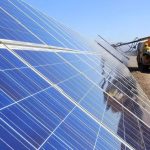Despite these efforts, the U.S. solar industry lags behind China’s. In 2023, the cost of Chinese solar panels fell by 42 percent due to a combination of state support, real innovation, and overproduction, making them 44 percent cheaper than U.S.-made panels. Additionally, Chinese manufacturers are at the cutting edge of solar panel innovation, with firms like JinkoSolar and Longi frequently setting new cell efficiency records. Today, U.S. manufacturing capacity is 26 gigawatts, compared to China’s over 1 terawatt (1,000 gigawatts) capacity. Nevertheless, the Biden administration continues to implement protective measures to support the U.S. manufacturing base against Chinese competition.
Reducing Reliance on China
While “de-risking” only recently entered U.S. policymakers’ lexicon, efforts to reduce reliance on Chinese solar supply chains have more than a decade of precedent. Currently, solar panels from China face several trade barriers: antidumping or countervailing duty tariffs, Section 201 and 301 tariffs, and restrictions under the Uyghur Forced Labor Prevention Act (UFLPA).
In 2012, the Obama administration’s antidumping investigation led to tariffs that reduced Chinese solar imports from 50 percent to 15 percent by 2018 (see Figure 3). Chinese manufacturers then shifted production to Southeast Asia as a consequence, focusing initially on module assembly and more recently on making investments in wafer and cell production. It was only in 2023, by which time nearly 80 percent of solar imports were from Southeast Asia, that the Department of Commerce released its determination that the majority of the value-add in panels produced in Southeast Asia by some firms was Chinese, and therefore subject to existing antidumping duties.
In 2018, the Trump administration launched a new tranche of tariffs utilizing the Section 201 mechanism, which provides temporary relief to allow domestic industry to adjust to surging imports. Unlike the previous antidumping tariffs, the Section 201 tariffs were global. However, the administration allowed an exclusion for bifacial solar panels, which later became the majority of U.S. imports.
The Biden administration extended these tariffs while also placing a 24-month “bridge” to allow imports from Southeast Asia deemed necessary for solar deployment in the United States, underscoring just how central imports from those countries had become for domestic installers, which had lobbied for exemptions. During this period, imports from Cambodia, Malaysia, Thailand, and Vietnam were shielded from both antidumping and Section 201 tariffs. In May of this year, the bridge period officially came to an end, exposing the vast majority of U.S. cell and panel imports to a tariff rate of 14.25 percent.
This post was originally published on 3rd party site mentioned in the title of this site





